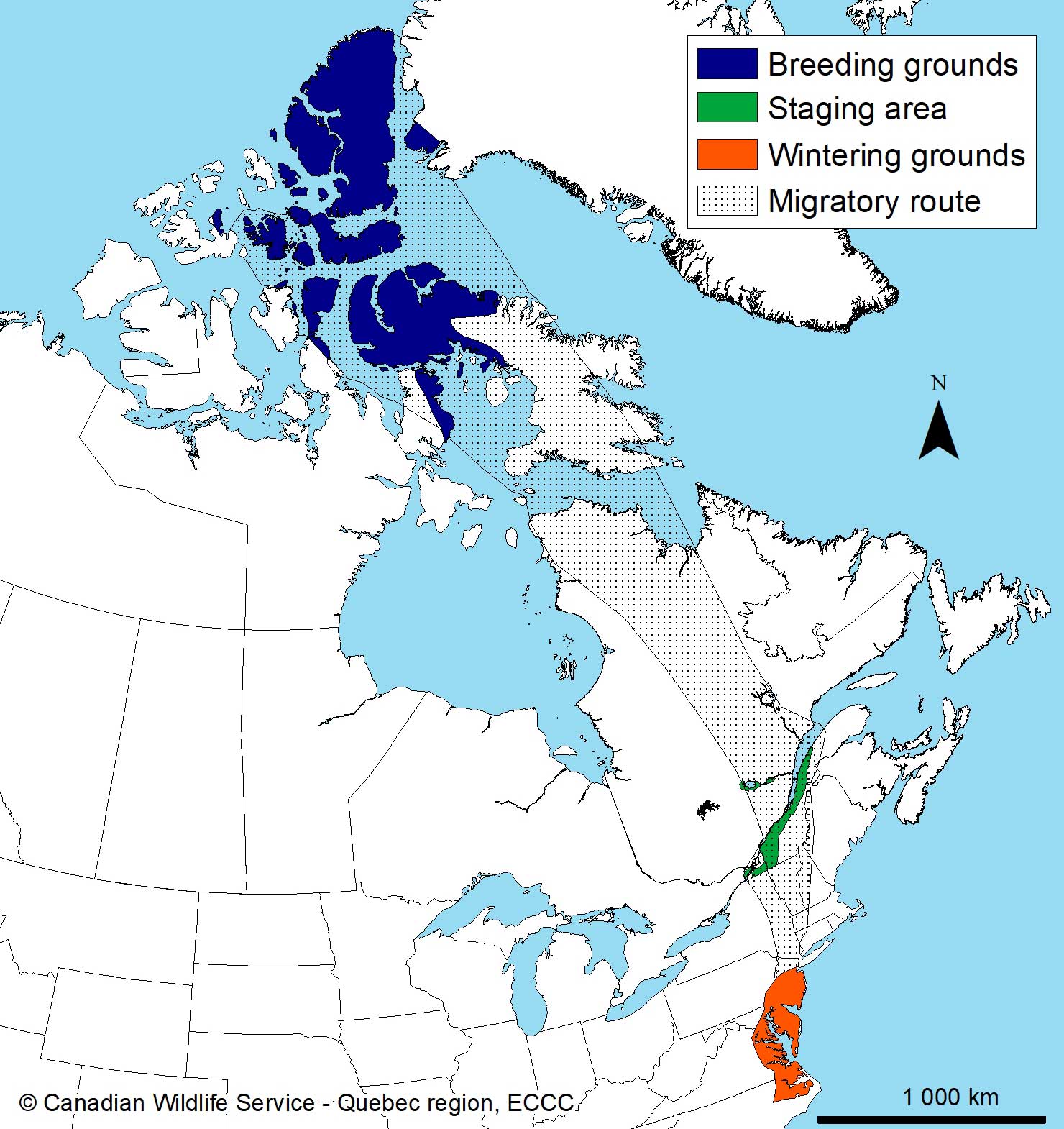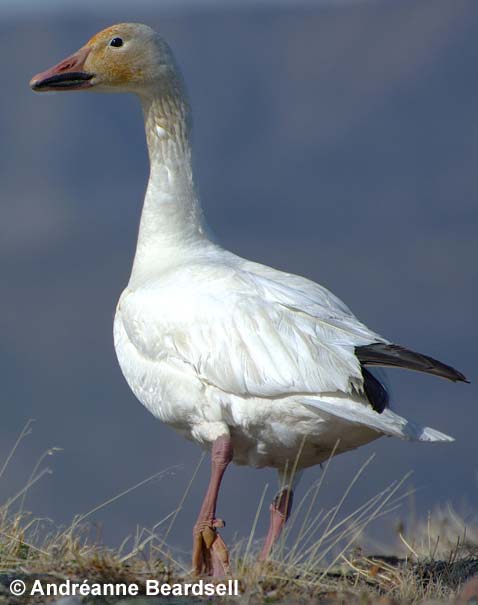
The greater snow goose is a large migratory bird that breeds mostly in the Eastern Canadian High Arctic, from North Baffin Island to North Ellesmere Island, with some birds also breeding in West Greenland. Geese come to the Arctic during the summer because the tundra provides good conditions to breed and raise goslings. For the rest of the year, geese migrate south to avoid the harsh Arctic winter.
During the migration, Greater Snow Geese follow a relatively specific route. Each year, they leave the Arctic at the end of August and migrate south through southern Quebec where they stay from 6 to 8 weeks, replenishing their body reserves in agricultural fields and tidal marshes. From this area, a 900-km flight south brings geese to their wintering grounds in the U.S. mid-Atlantic states, from New Jersey to North Carolina. In spring, greater snow geese depart from their wintering grounds, once again spending 6 to 8 weeks in southern Quebec before leaving for their Arctic breeding grounds (3,000 km north). Birds leave their migratory stopovers between 15 and 25 May to arrive on their breeding grounds between late May to early June.
Population size
Since 1965, the Canadian Wildlife Service has conducted an annual aerial photographic survey of greater snow geese during their spring migration to estimate the population size. This survey takes place in late April or early May (depending on the weather) when the entire population is present in southern Quebec. Five aircrafts are used simultaneously in order to cover, in one day, the large territory extending from Lac Champlain, QC, in the south to Lac St-Jean, QC, in the north and from eastern Ontario in the west to Baie-des-Chaleurs in the east. Every flock encountered is photographed and used to estimate the population size.
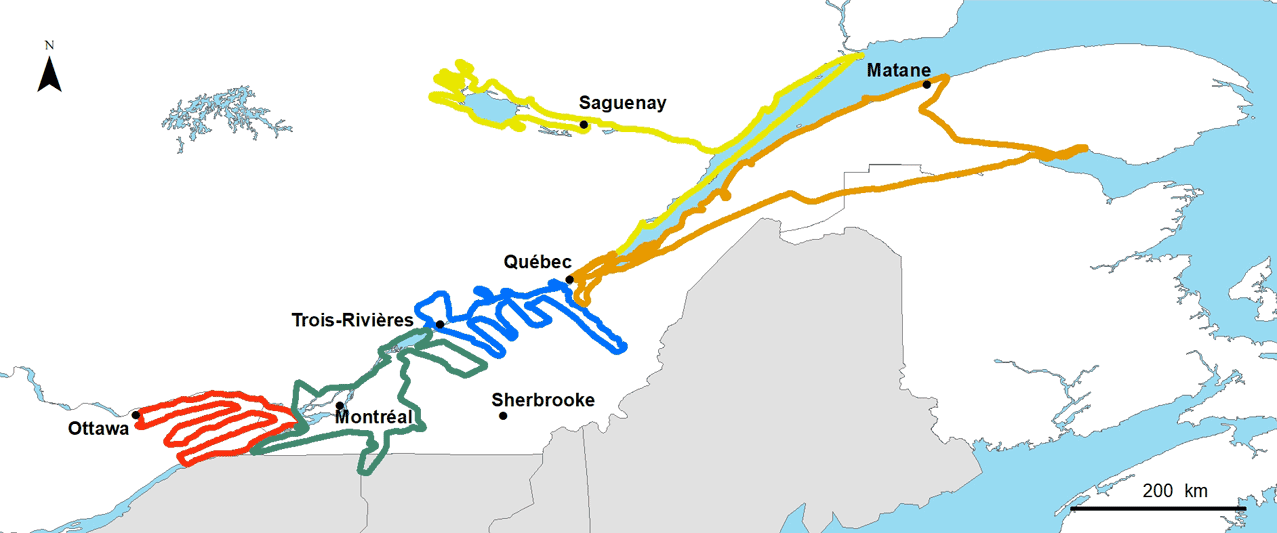 |
| Sectors surveyed during the greater snow goose spring survey. |
Like many other goose species, the greater snow goose has seen its population size dramatically increasing since the 1960s. One of the main factors responsible for this expansion is the extensive use of agricultural fields which provide them with an unlimited food resource during winter (US east coast) and migratory stopovers (in southern Quebec). A consequence of this population explosion is that greater snow geese are imposing a large stress on their fragile Arctic breeding habitats. In order to stabilize the growth of this goose population, management actions during spring, autumn and winter have been undertaken since 1999 in Canada and 2009 in the United States. The main goal of these measures was to stabilize the population at one million individuals or less. The Canadian Wildlife Service and the Atlantic Flyway Council set a population goal between 500,000 and 750,000 geese, which would allow maintaining a healthy population and reducing the risks of affecting the ecological integrity of habitats and their biodiversity. So far, these measures have succeeded in stabilizing the population size.
Breeding ecology
Since Bylot Island has the largest breeding colony of greater snow geese in the Canadian High Arctic, it provides an exceptional setting for the study of its breeding ecology and its impact on the Arctic habitat. Upon their arrival, geese concentrate in areas such as south facing hills and creeks, where the snow melts first and uncovers the vegetation. Geese initially feed in those areas but quickly move to the lowlands, their preferred habitat for nesting as snowmelt progresses.
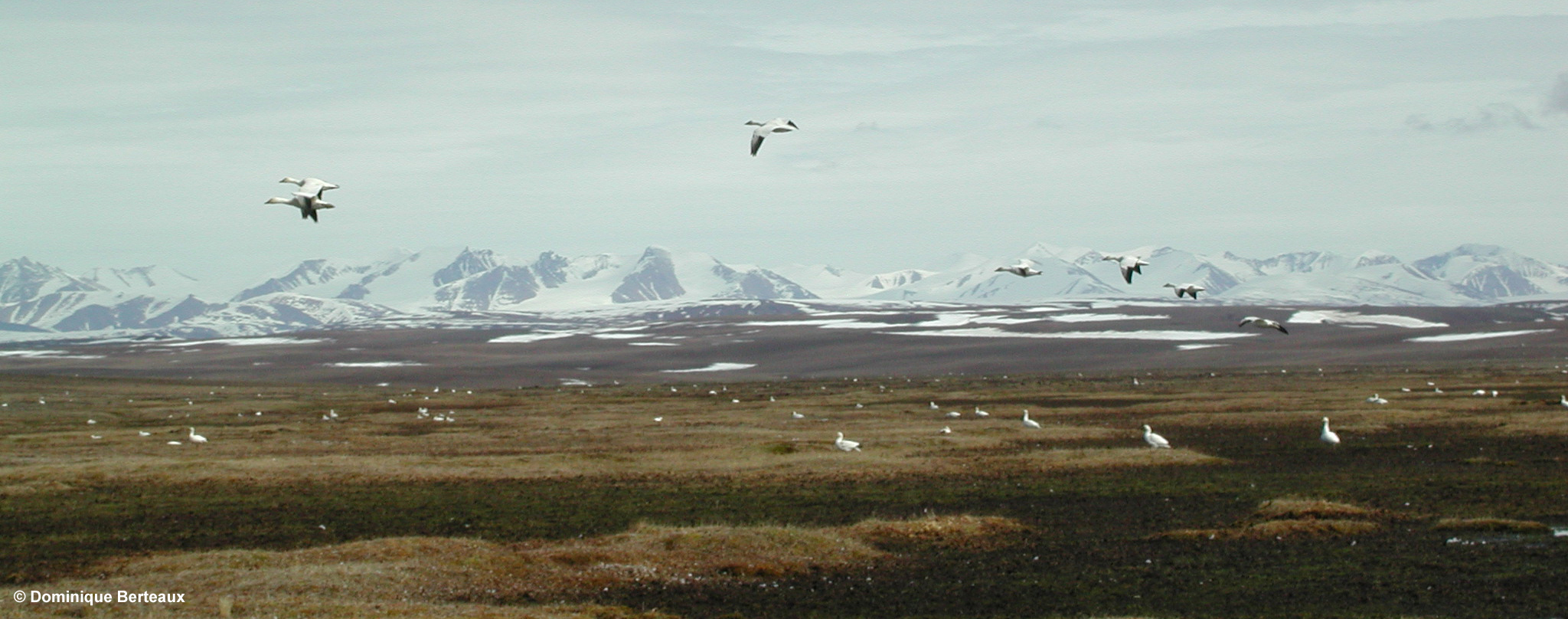
The distribution of snow geese on Bylot varies throughout the summer. During the nesting period from June to early July, geese are mostly concentrated in a 20 km² area a few kilometers north of Pointe Dufour near the coast. In this colony, nest density is high, averaging around 510 nests per square kilometer (range: 42 to 1053). In years of high reproductive effort (i.e. high number of geese breeding), the main colony expands, and other nesting areas are also used elsewhere on the island, although less intensively.
The variation in the number of birds spending the summer on the island is dictated by spring weather conditions and breeding success. Geese cannot build their nest before nesting sites are snow-free. The average laying date of snow geese on Bylot Island is 12 June (range: 6 to 20 June). Annual variations in the average egg laying date are strongly related to weather conditions in spring, being earliest when snowmelt is early and latest when it is late.
When snowmelt is delayed, many birds may forego breeding because not enough time will be left to complete the reproduction before autumn freeze up. Incubation has a set time length in birds, and for greater snow geese hatching always occurs 23 to 24 days after the last egg is laid. Hatching is synchronous within a nest and all eggs usually hatch within 24 hours. Therefore, egg hatching dates follow the same trends as laying dates: if geese lay their eggs early one year, eggs will also hatch early too. The average hatching date on Bylot Island is 9 July (range: 3 to 15 July).
The clutch size influences the length of the laying period as laying interval between each egg is about 34 hours. The clutch size shows a strong inverse relationship with the laying date: it is large when geese lay their eggs early and small when they lay their eggs late in the season. A reduced clutch size in late years is probably because females have a reduced physical condition due to limited feeding opportunities and a shorter summer to raise their brood. The overall average clutch size of greater snow geese on Bylot Island is 3.7 eggs per nest (range: 3.1 to 4.4).
On Bylot Island, the main cause of nesting failure for snow geese is predation. In decreasing order of importance, the main predators are the arctic fox, parasitic jaeger, glaucous gull and common raven. On average, nesting success is 66% but this parameter varies considerably among years (range: 14 to 90%). Environmental conditions and, most importantly, predator density determine nesting success. Success is low as well when the reproductive effort is reduced due to late snowmelt. Nesting success also tends to show periodic variations due to cyclic fluctuations in lemming abundance (see Lemmings). When lemmings are low, predators like foxes and jaegers will turn to geese and rob many eggs, leading to poor nesting success. This effect is amplified in areas where the density of goose nests is low, such as in areas away from the main goose colony.
Among nesting birds, those that lose all their eggs to predators will not renest. More than 90% of geese that are not able to reproduce or lose their nest leave the island in early summer for other Arctic regions. As it is the case for many water birds, geese molt (shed and replace) all their flight feathers at once every summer, which leaves them flightless and vulnerable to predators. Non-breeders or failed nesters thus leave the island for molting areas that provide a better protection against predators, unlike parental birds that stay with their young and molt with them on Bylot Island.
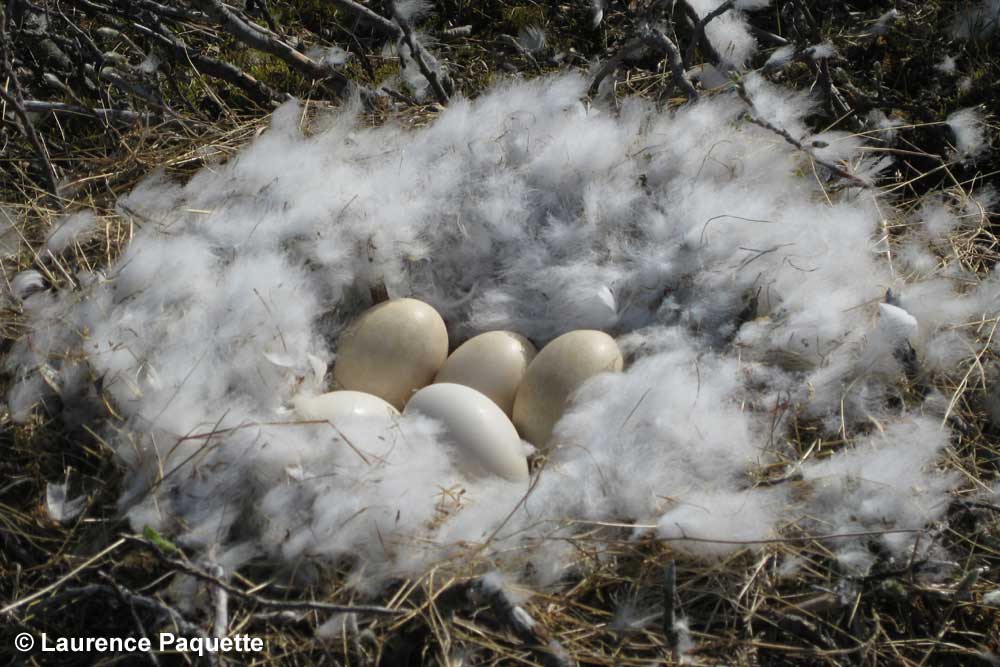 |
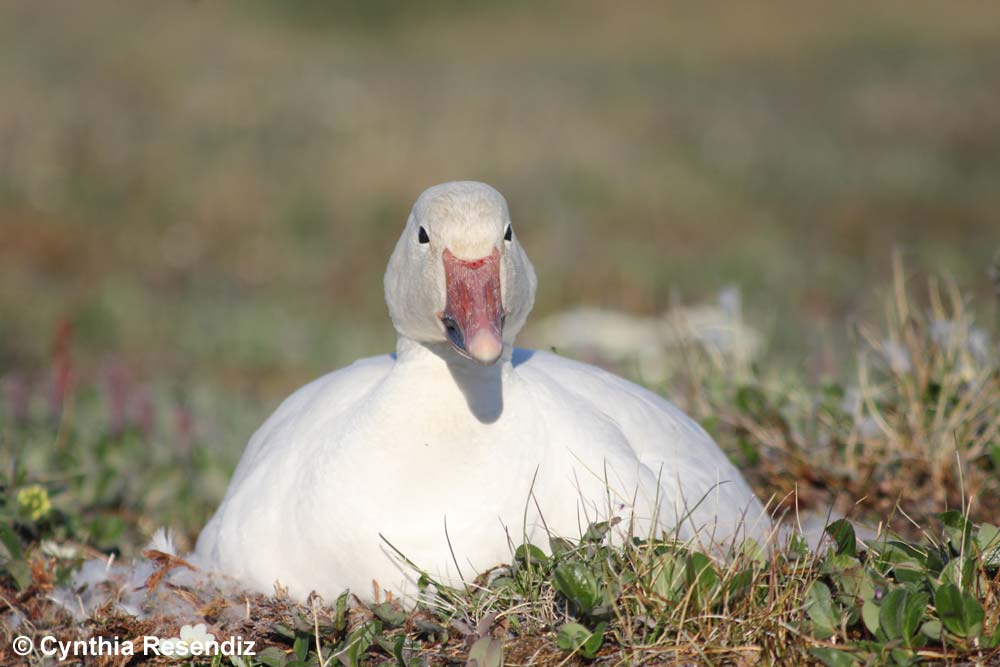 |
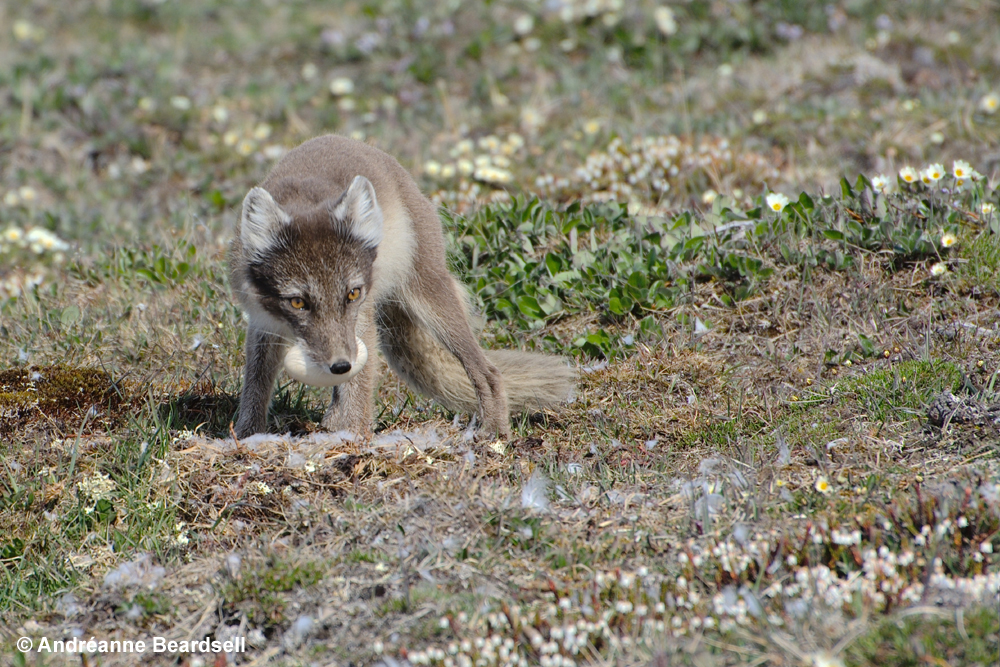 |
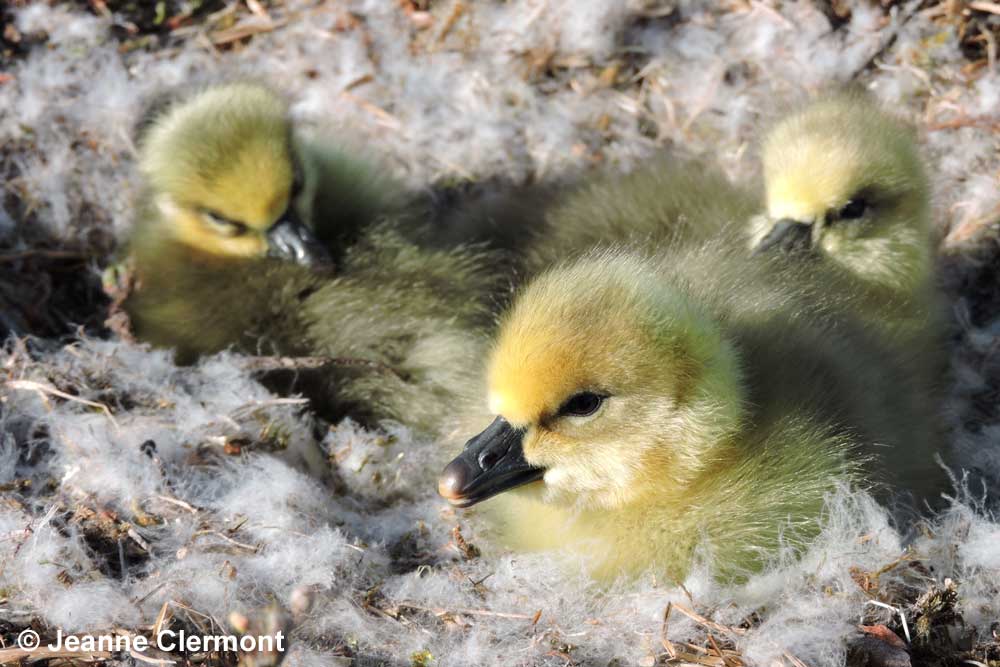 |
After hatching, many families leave the nesting colony and disperse throughout the island, concentrating in areas that have a high density of wetlands. These sites offer a high abundance of plants preferred by goslings, and many ponds that provide a refuge for families in case of attacks by predators. Families can move up to 50 kilometers in a few days to settle on a suitable brood-rearing area on the island. In late summer, many families move to upland areas, sometimes high up on mountain slopes. Depletion of food in wetland areas combined with an abundance of fruiting plants in upland areas at that time explain these movements. Our most important monitoring activity during this period is the capture and marking of large number of goose families. Marking individuals is very important to study the survival and movements of long-lived birds like geese. Measurements and weighting of captured goslings provides further information on their growth during the summer. To learn more about our marking program, please visit our Greater Snow Goose Demographic Studies website.
The full dataset of our goose nesting monitoring on Bylot Island is available on NordicanaD.
Brood density and distribution on Bylot Island
The actual number of geese breeding on Bylot Island varies remarkably from year to year. In good breeding years, up to 70,000 adults have been observed on the island during the summer but in poor breeding years, the number of adults can be as low as 2,000. In order to monitor the number and distribution of snow geese on Bylot Island, the Canadian Wildlife Service conducted aerial surveys during the brood-rearing season at 5-year intervals between 1983 and 2008. Besides numbers and distribution, surveys also provided information on age (adult or goslings), reproductive status (breeder or non-breeder) and types of habitat used by geese.
As the snow goose population increased, its distribution on Bylot Island also changed. At low breeding numbers (e.g. 1983 and 1988), brood distribution was characterized by few areas of high and moderate brood densities, with a large part of the south plain presenting low brood densities. With the increasing numbers (1993 and 1998), the area of high to moderate densities greatly expanded, leaving only a small area with low brood densities.
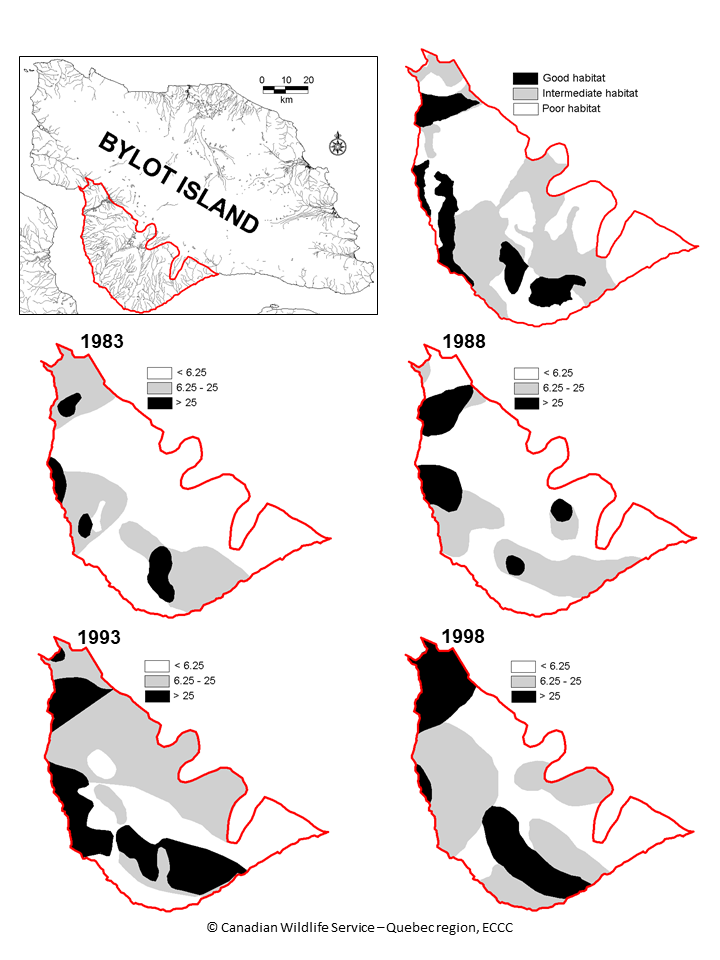
| Arctic fox |

